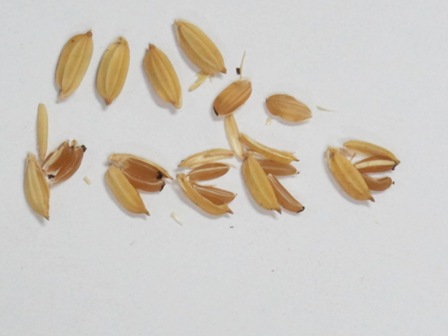Thanks to Mike Jackson for taking up the challenge of finding more examples of double-grained rice. He got in touch with friends at his old stomping grounds in the IRRI genebank, and the indispensable Ms Flora de Guzman there, who heads of that genebank past and present will I’m sure forgive me for saying actually runs the place, 1 came up with a variety from Nepal called Laila Majnu. This was sent to IRRI in 1981, and is conserved in the genebank as accession IRGC 59101 (and incidentally safety duplicated at Svalbard). The fact that IRGC 59101 (which is pictured below, thanks to Ms de Guzman again) is a bit of a strange morphological variant isn’t mentioned in the genebank database, however. Not the electronic version, anyway. Ms de Guzman simply remembered the variety and dove back into her notebooks to find it. Next time I think about venturing into Genebank Database Hell, I want her as my guide…

Local rice landraces in Nepal are being replaced by MV. There
is a consequent decline in the richness and evenness of genetic
diversity, increasing the risk of genetic erosion and extinction of unique varieties such as Laila Majnu (literally means lovers) and Amaghauj (literally means cluster of mango). We have been monitoring rice diversity on farm at least two sites (about 1000 HHs) in Nepal since last 14 years with the help of our NGO partner LI-BIRD (www.libird.org) and through network of community genebank. The loss of such unique varieties are high because access to information and materials are limited to few farmers. bara farmers constructed community level genebank to conserve such local varieties and regenerate each year and store using local methods with the objective of sharing materials fellow farmers. Community genebank is known for outlet of local varieties and Agrovets are seen as the outlet of MV and hybrid seeds. Until 1999 on-farm monitoring Amaghoj (see picture) was grown by one farmer on 3 katha land but it was discontinued the variety as land was sold to other farmer. This local variety has a cluster of spikelets (at least 3 potential grains) originated at the same base; this heritable trait can be used in designing potential new rice type with increased yield potential. This was reminded this blog and there must be many more. I was told that in Yunnan, Malaysia and also in Taiwan you have a range of colored rice -ranging from purple, black, red to yellow -with potential nutritional health value. We have not yet appreciated what we are blessed with?
There is great potential to link community seed bank and national seed bank to harness such untapped and unknown resources. Our partner LI-BIRD and NARC (National genebank) used community seed bank as a platform for such knowledge documentation and gene storage and mechanism of PIC to access and benefit sharing!
I can attach photo herein so I will send you by email for your action
Over the past 15 years we have been conserving JUGAL (double-kernel) and SATEEN (triple-kernel) rice varieties on our conservation farm, both accessd from West Bengal. For in situ conservation of these varieties, we received Plant Genome Saviour Recognition Award in 2009 from the Ministry of Agriculture, Government of India. The morphological details of these two varieties were published in Seed Research journal of the NBPGR, New Delhi [Deb, Debal and Debdulal Bhattacharya 2009. Two unique landraces from West Bengal. Seed Research 37 (1&2): 152-155.].